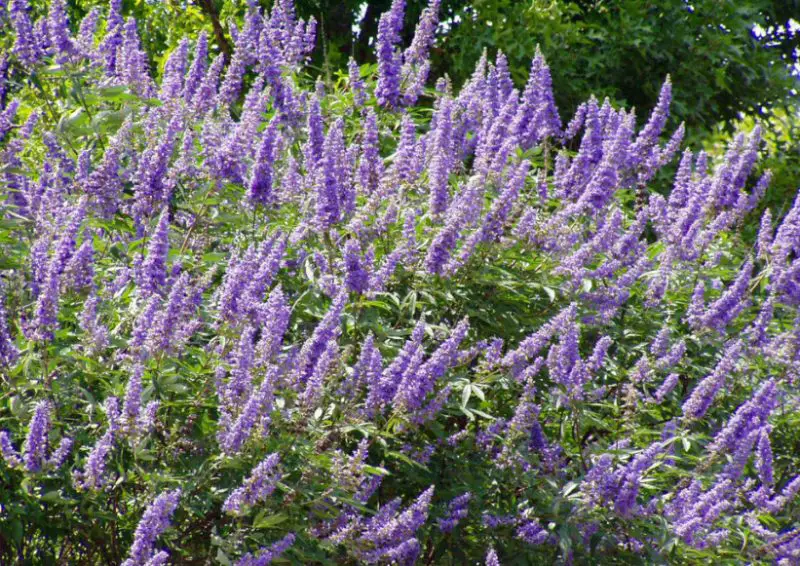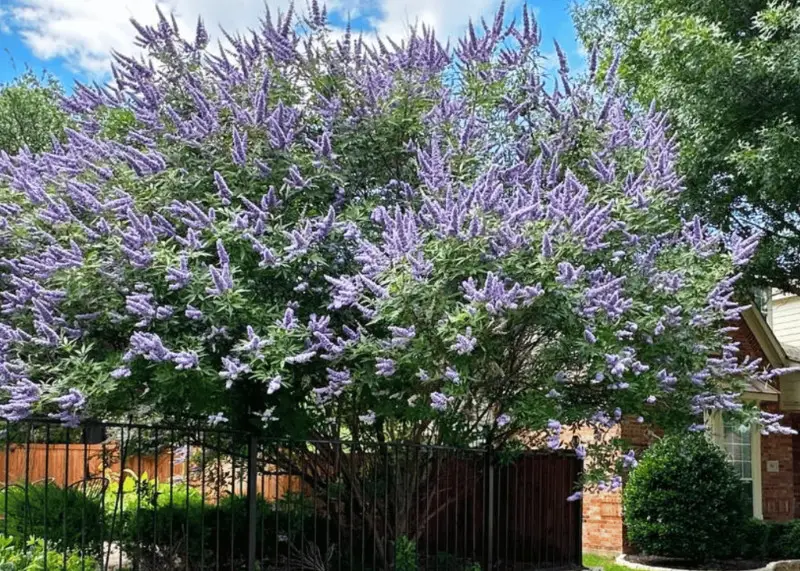In the sprawling landscapes of Texas, the Vitex tree stands as a testament to resilience and beauty. As a cherished addition to gardens and green spaces across the state, the Vitex tree, with its vibrant blooms and adaptability, adds a touch of elegance to the Texan scenery.
From its common name, Chaste tree, to its botanical identity, Vitex agnus-castus, this plant has a rich history and a myriad of benefits for both gardeners and nature enthusiasts alike.
Let us delve into the enchanting world of the Vitex tree in Texas, exploring its characteristics, care requirements, and its enduring charm in the Lone Star State’s diverse landscape.
About Vitex Tree in Texas

The Vitex tree, also known as the chaste tree, vitex, chasteberry, or lilac chastetree, is a stunning addition to the Texan landscape. Its botanical name, Vitex agnus-castus, belongs to the Lamiaceae family, which encompasses a variety of aromatic plants.
This tree exhibits versatility in its growth patterns, appearing as both a tree and a shrub, with mature sizes ranging from 8 to 20 feet tall and 5 to 20 feet wide. Its adaptability makes it suitable for various landscaping needs, whether as a standalone focal point or as part of a lush green backdrop.
Thriving under full sun exposure, the Vitex tree requires well-drained soil, capable of sustaining it through Texas’ diverse climatic conditions. Its tolerance to soil pH levels ranging from acidic to alkaline ensures its resilience in different environments.
The Vitex tree graces the Texan scenery with its captivating blooms during the spring and summer months. Displaying a spectrum of colors, from regal purples to delicate pinks and pristine whites, its flowers attract pollinators and add a burst of vibrancy to any garden or park.
Adaptable to hardiness zones 7 to 8 according to the USDA classification, the Vitex tree finds its roots in Europe and Asia. Despite its origins, it has seamlessly integrated into the Texan landscape, enhancing its beauty and diversity.
Vitex Tree Care
Taking care of a Vitex tree, also known as a chaste tree, is a straightforward task, making it an ideal choice for home gardeners. With a few simple steps, you can ensure its health and vitality, enhancing your outdoor space with minimal effort. Here are the key care requirements for cultivating a thriving chaste tree:
Light
The Vitex tree, is adaptable to various light conditions but thrives best when planted in a sunny location. Ideally, select a spot that receives at least six hours of direct sunlight daily to encourage optimal growth and abundant flowering.
While the vitex tree can tolerate partial shade, its most impressive blooms will be seen when it basks in full sun. Whether you’re landscaping a garden or adorning a patio, providing ample sunlight ensures that your chaste tree will flourish and grace your outdoor space with its vibrant beauty.
Soil
When selecting a spot to plant the Vitex tree, it’s crucial to prioritize well-draining soil conditions. Opt for a location where water drains efficiently rather than accumulating, preventing waterlogged roots and potential rot issues.
While the vitex tree is adaptable to a range of soil pH levels, from acidic to slightly alkaline, it thrives best in soil that isn’t overly rich. Rich soil tends to retain excess moisture, which can be detrimental to the plant’s health. Originating from Mediterranean regions, the vitex tree prefers soil on the drier side, making it well-suited for sandy or rocky soils.
Water
Once established, caring for a vitex tree in terms of watering is minimal in most regions. Typically, you won’t need to water it at all once it has taken root and acclimated to its environment. It’s important to note that overwatering can be detrimental to the health of the tree.
In fact, it’s advisable to avoid using organic mulches, as they can retain excess moisture around the roots. By allowing the vitex tree to rely on natural rainfall and avoiding supplemental watering, you can promote its overall health and resilience in your garden or landscape.
Temperature and Humidity
The Vitex tree, with its impressive adaptability, thrives across a wide range of climates, making it a versatile addition to gardens from Zones 6 to 9. While technically hardy down to approximately minus 9 degrees Fahrenheit, in Zone 6 it often behaves more like a perennial, regrowing from the ground each spring after winter dieback.
Remarkably, this resilient tree flourishes in diverse environments, equally at home in the high humidity of the southeastern United States as it is in the arid climate of the Southwest. Its ability to withstand varying temperatures and humidity levels underscores its appeal as a hardy and reliable choice for landscaping in a broad spectrum of geographical regions.
Fertilizer
Caring for a vitex tree in terms of fertilization is refreshingly simple. This resilient tree typically doesn’t demand much, if any, feeding. At most, a single application of a general-purpose balanced fertilizer every year or two is all that’s necessary to support its growth and vitality.
When applying fertilizer, it’s essential to follow the instructions provided on the product label to ensure optimal results. With minimal fertilizer requirements, the vitex tree proves itself as an easy-to-care-for and low-maintenance addition to any garden or landscape.
Pruning
Pruning plays a vital role in shaping and maintaining the health of a vitex tree, also known as chaste tree. If left unpruned, this versatile shrub can grow into a sprawling, vase-shaped form, reaching heights of 20 feet or more with an equally wide spread. However, with strategic pruning, it can be trained into a single-trunk small tree by removing competing shoots to encourage a central leader. Early winter pruning helps to keep the shrub in an attractive shape and control its size, ensuring it remains a stunning focal point in the garden.
One of the benefits of pruning is the encouragement of continued flower production. Deadheading spent flowers, although it can be a meticulous task with larger shrubs, can stimulate a second flush of blooms approximately six weeks after the initial flowering. This technique ensures a prolonged display of the vitex tree’s vibrant and fragrant flowers throughout the growing season.
In colder climates, a more drastic pruning approach is often employed, where the plant is pruned down to the ground just before winter. Since the vitex tree flowers on new wood, it will reliably return each year as a 3- to 5-foot flowering shrub, even after such a fierce pruning routine. This annual rejuvenation ensures the continued health and vigor of the vitex tree, making it a resilient and enduring feature in gardens across various climates.
Overwintering
Overwintering the vitex tree typically poses minimal concern within its recognized hardiness range, as it often requires no special protection. However, in colder climates such as Zone 6 and occasionally Zone 5, some gardeners adopt a perennial approach. They cut back the vitex tree to ground level each winter, allowing it to regenerate from the roots come springtime. Remarkably resilient, this practice results in annual growth of 3 to 4 feet, with the tree reaching flowering maturity each season.
Propagating Vitex Tree

Propagating a vitex tree is a straightforward process, offering gardeners the opportunity to multiply their plants with ease. The most common method involves rooting branch cuttings, a technique that takes advantage of the plant’s natural ability to establish roots readily.
To begin, select a healthy 12- to 18-inch branch tip in early summer, ensuring it is free from disease or damage. Using sharp pruners, remove the flowering end portion of the cutting, as it’s unnecessary for propagation purposes. Strip the leaves from the bottom half of the cutting to expose the nodes.
Next, place the cutting in a vase of water, positioning it in a location that receives morning sun but afternoon shade. Alternatively, you can plant the cuttings directly into moist potting soil in a container. Over the course of approximately two months, the leaves on the cuttings may drop off, but new growth will emerge from the nodes, indicating successful rooting.
Once the bottom of the cutting develops hairlike roots, typically signaled by the presence of new growth, it’s ready to be transplanted. Carefully transfer the cutting into a pot or directly into a garden location, ensuring it receives adequate sunlight and moisture as it continues to establish itself. With patience and proper care, propagated vitex trees can thrive and contribute to the beauty of any landscape.
Common Pests & Plant Diseases
The vitex tree is generally resilient against pests and diseases, with issues such as root rot, nematodes, and leaf spot being relatively uncommon. These problems tend to arise when the soil is overly moist, underscoring the importance of well-draining soil for the plant’s health.
However, aphids, whiteflies, and scales may occasionally pose a threat, although they can typically be managed effectively with horticultural soaps and oils. It’s crucial to ensure the vitex tree is grown in well-draining soil to prevent the risk of fatal root rot, emphasizing the significance of maintaining appropriate soil conditions for the plant’s longevity and vigor.
How to Grow Vitex Tree from Seed
Growing a Vitex tree from seed can be a rewarding endeavor, offering the opportunity to nurture new plants from scratch. If you’re interested in propagating Vitex from seeds, here’s a simple guide to get you started:
- Collect the fallen fruits from existing Vitex trees and extract the seeds. The seeds are typically found within the fruits and can be easily separated for planting.
- Choose a sunny spot in your garden or prepare a temporary pot with well-draining soil. Vitex trees thrive in sunny locations with soil that allows for proper drainage.
- Sow the seeds about 1/8 inch deep in the soil, ensuring they are adequately covered but not buried too deeply.
- Water the soil thoroughly after planting to ensure proper moisture levels for germination. Afterward, allow the soil to dry out slightly between waterings, as Vitex trees prefer soil that is not constantly wet.
- Consider allowing the seeds to experience a winter outdoors, as this may be necessary for germination. Fall is an ideal time to sow Vitex seeds, allowing them to naturally undergo the cold stratification process required for successful germination.
- If you choose to grow the seeds in a pot, transplant the seedlings into a permanent location in your garden once they have germinated and developed into sturdy young plants. Ensure the new location receives ample sunlight and has well-draining soil to support healthy growth.
Potting and Repotting Vitex Tree
Potting and repotting a smaller cultivar of the vitex tree in a container is a straightforward process, making it an excellent choice for gardeners with limited space or those who prefer container gardening. These smaller cultivars typically grow to heights of 3 to 6 feet, making them well-suited for potting.
To pot or repot a vitex tree, follow these simple steps:
- Measure the root ball of the tree to determine the appropriate container size. Choose a pot that is at least 8 inches larger in diameter than the root ball to allow room for growth. Ensure the pot has several drainage holes to prevent waterlogging, which can lead to root rot.
- Line the bottom of the pot with landscape fabric to prevent soil from escaping through the drainage holes while still allowing excess water to drain freely.
- Prepare a well-draining potting mix by blending a good quality soil with approximately 10 percent perlite. This mixture promotes healthy root growth by ensuring adequate drainage and aeration.
- Carefully pot up the vitex tree, ensuring the root ball is positioned at the same level as it was in its previous container. Fill the pot with the prepared potting mix, gently firming it around the roots to provide stability.
- Water the newly potted tree thoroughly, allowing excess water to drain away. Place the container in a sunny location, as vitex trees thrive in full sun.
By following these steps, you can successfully pot or repot a vitex tree, providing it with a suitable environment to thrive and flourish in a container. With proper care and maintenance, container-grown vitex trees can add beauty and interest to patios, balconies, and other small spaces.
How to encourage Vitex Tree to produce more flowers
To coax your Vitex tree into a spectacular bloom season, you’ll want to focus on optimizing its sunlight exposure and reining in any excesses in fertilizer. This Mediterranean beauty is known for its extended bloom period, spanning from early summer through September. However, if your Vitex seems to be holding back on its floral display, it’s time to troubleshoot.
First and foremost, assess the sunlight situation. Vitex trees thrive in full sunlight, so if yours isn’t getting an adequate dose, it could be affecting its bloom potential. Ensure that your tree is planted in a location where it receives at least six to eight hours of direct sunlight daily. Sometimes, nearby structures or overhanging branches can cast unwanted shade, so consider pruning or relocating if necessary to maximize sun exposure.
Next, take a closer look at your fertilization practices. While it’s tempting to shower your plants with nutrients in hopes of boosting their growth and blooms, Vitex trees are quite content with minimal feeding. In fact, excessive fertilizer can actually hamper flower production by encouraging lush foliage growth at the expense of blossoms. If you’ve been liberally applying fertilizer, it’s time to dial it back. Stick to a balanced fertilizer formulated specifically for flowering plants, and apply it sparingly, following the manufacturer’s instructions.
Additionally, ensure that your Vitex tree is planted in well-draining soil. Waterlogged roots can stress the plant and inhibit blooming. Consider amending heavy soils with organic matter to improve drainage and create a healthier growing environment for your tree.
By optimizing sunlight exposure, moderating fertilizer application, and ensuring proper soil conditions, you’ll provide your Vitex tree with the ideal conditions to unleash a profusion of blooms, transforming your garden into a vibrant haven of color and fragrance throughout the summer months.






